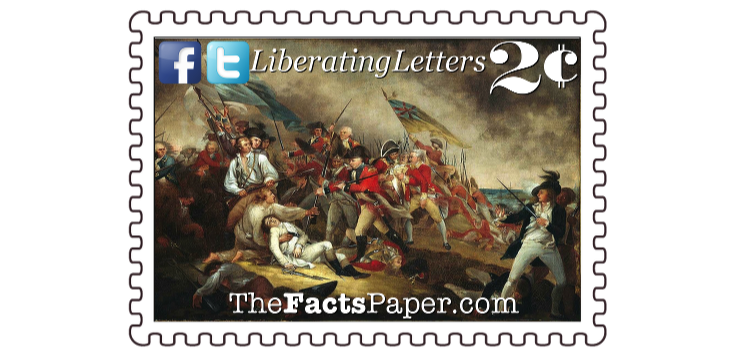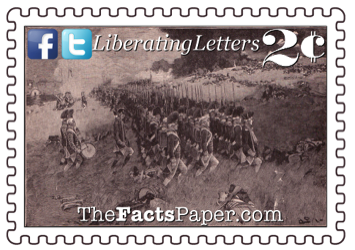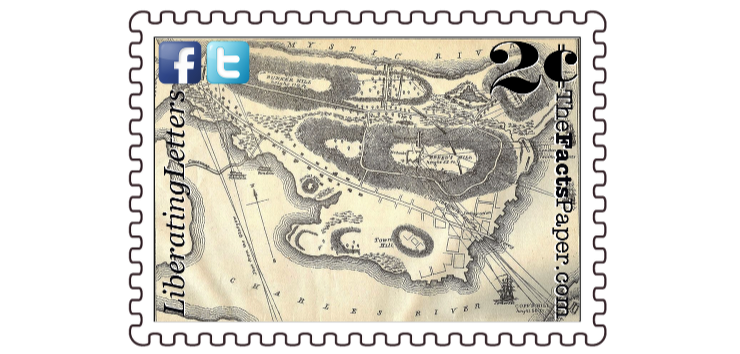Crowds gathered in anticipation as the day's event began to unfold. Church steeples, housetops, and every high point in Boston hosted men, women, and children of all ages wanting to watch the battle and their future. Leaders reviewed their troops as they presented them with words of encouragement and support. Untrained and carrying their own muskets, these simple colonists didn't even have uniforms, yet they were unified in something much more important: the desire and determination to be free. As they watched the enemy arrive on shore, Colonel William Prescott considered their minimal ammunition and instructed them, "Don't shoot until you see the whites of their eyes." (See The Bookstore General)
Dressed in fresh, clean red coats, the enemy formed their lines to approach the fortification and attack. Well-supplied and trained, they were convinced of an easy victory. By 3 o'clock in the afternoon, they began making their way up the hill, anticipating a defensive attack that was not coming. Therefore, many began wondering if there would even be a battle at all. When the British reached within 45 yards of the fortification, the occupants opened fire with such precision the Red Coats soon retreated so as not to lose all their men. Moans and wails from the wounded in the field filled the air as they regrouped for a second attack. Meanwhile, bombardments from batteries and ships continued their barrage of artillery fire on the redoubt.
To divert attention, the 600 wooden buildings in Charlestown, just south of Breed's Hill, were set ablaze by the British, but the colonists were not deterred. The second attack produced the same outcome as the first as the colonists proved to be a formidable opponent, yet their ammunition was running extremely low. Despite the constant raining of artillery along with the destruction of Charlestown, they held their position for an anticipated third strike. This time the British hesitated, fearing they may not have enough willing and able men yet hope returned with the arrival of 1,000 fresh troops. As the colonists' firepower dwindled, the Red Coats reached the redoubt and engaged in hand-to-hand combat, attacking the colonists with bayonets. Without equal weaponry, the Americans were forced to begin retreating as they continued to defend the hill with the butts of their guns.
During the chaos, Britain's Major John Pitcairn mounted the redoubt wall, insisted the colonists surrender, and declared, "The day is ours!" For a moment the men stood and stared in disbelief, convinced all had been lost. With quick action, Peter Salem raised his musket and fired. Pitcairn fell into the arms of his son, William, who cried, "I have lost my father." Distraught, William carried his father away as troops helped. Salem's shot not only fatally wounded the beloved commander, it also severally affected the morale of the Red Coats. Their fight diminished, which allowed the colonists to escape what could have been a brutal and deadly defeat. They retreated with the casualties they could save, as the British began to capture many fatally wounded prisoners. Pitcairn was removed to Boston where he died.
Peter Salem, the battle's hero, was born into slavery in 1750 in Framingham, Massachusetts, and celebrated his birthday on October 1. He was originally owned by Jeremiah Belknap, yet it is believed he was bought by Major Lawson Buckminster in early 1775. Blacks, both free and slave, were barred from military service since the late 1600’s due to fears of a slave insurrection. However, as men were needed, free blacks were allowed to enlist. Therefore, Buckminster freed Salem, who immediately became a minuteman in Captain Simon Edgel's company. In addition to Bunker Hill, he fought in the Battle of Lexington and Concord as well as Saratoga and Stony Point. (see The Shot Heard ‘Round The World and Pivot Points)
In efforts to hinder the Americans, Virginia Governor Lord Dunmore declared that any slave who fought for the British would win their freedom. Being the British crown forced slavery on the colonies, refusing to let them abolish it, this only further convinced the Americans how tyrannical King George III was. (see The Forgotten Midnight Ride) Therefore, General George Washington allowed all blacks to enlist, both free and enslaved. (see The Forgotten Hero, The Color Patriotism, and The Forgotten Black Founding Father)
Salem could have easily taken up arms for the British or not engaged at all. However, he understood the bigger battle and valiantly fought for America. His shot not only saved hundreds of lives that day, it likely affected the whole war as the British lost an important military leader. In addition, the colonists escaped total annihilation, giving them much needed confidence. Discharged on March 1, 1780, from the regular army, Salem remained a member of the Framingham Militia until the close of the war. In September 1783, Salem married Katy Benson, yet the childless marriage dissolved after 1790. He lived in Leicester as a free man, working for himself as a cane weaver, until his death on August 16, 1816. He was buried in the Old Burying Ground in Framingham, where the town erected a monument at his grave in 1882.
After performing an impressive defense, the colonists received the majority of their casualties in the Battle of Bunker Hill during their evacuation. Among them was Dr. Joseph Warren, who sustained a fatal head wound from a musket ball. This was an equally devastating loss for the Patriots as Pitcairn was for the British.
Born June 11, 1741, Joseph Warren entered Harvard (see "Higher" Education) at age 14 and was practicing medicine in Boston by age 22 as the city's youngest, as well as one of its most prominent, doctors. Leaders in the Patriots’ cause, such as Samuel Adams (see Tree of Liberty and Tyrants And Tea Parties), John Adams (see A Dream Within A Dream) and his son John Quincy (see History Rhymes Again), and John Hancock (see Acts Of Oppression), sought Joseph's services. Likewise, Loyalists and British officials, including General Thomas Gage and his wife Margaret, as well as Governor Thomas Hutchinson's children, were patients of Warren. When 10-year-old Christopher Snider was shot and killed on February 22, 1770, which helped lead to the Boston Massacre, Warren performed the autopsy. (see Mayhem And Massacres) Some surmise his position allowed him to spy on British activity, which he reported to his fellow Sons Of Liberty Patriots.
Three days before the battle, the Massachusetts Provisional Congress appointed Warren a major general over the states' forces. Despite his military and patriotic leadership thus far, Warren declined to take command believing there were more qualified officers. Instead, he borrowed a musket and joined the troops, which included 19-year-old Henry Knox (see The Bookstore General) and Daniel Shays (see Reading The Riot Act), in the redoubt to defend the hill as a volunteer with the rank of private.
Following the Intolerable Acts in 1774, Warren drafting a set of resolutions declaring "no obedience is due" to the Acts. (see The Forgotten Battle) Representatives from all Suffolk County towns agreed on Warren's "Suffolk Resolves," which proposed boycotting British goods and mustering local militias for battle. Warren turned to his fellow Patriot Paul Revere to make the 5-day trip to Philadelphia and deliver the Suffolk Resolves to the Continental Congress, who overwhelmingly endorsed them despite Gov. Hutchinson declaring them "undoubtedly treasonable.”
On April 18, 1775, Warren again called on Revere as well as William Dawes to travel by land and sea for their famous midnight run to warn the militias of the Red Coats’ arrival. A third Patriot and free black man, Wentworth Cheswell, rode north to arouse militiamen there. (see The Forgotten Black Founding Father) Pitcairn led the Red Coats into Lexington and despite commanding his men not to fire until fired upon, it is believed the shot that rang out to begin the historic revolution came from within Pitcairn's troops. (See The Shot Heard 'Round The World)
Soon after, Warren authorized Captain Benedict Arnold to gather a militia and attack the British Fort Ticonderoga in northeast New York. (see A Tale Of Two Patriots) Henry Knox led an expedition to the fort in December of 1775 to retrieve the munitions still in the fort, which Washington used to drive the British out of Boston. (see The Bookstore General) Even after his death, Warren’s efforts helped the Americans win the war.
Following the Battle of Bunker Hill, the British buried the dead, including the Patriots left on the battlefield. Warren was placed in a shallow grave along side a fallen farmer until the Red Coats left Boston on March 17, 1776. Bodies were then exhumed for proper burial elsewhere, yet they were severely decayed. An amateur dentist, Revere had fashioned a false tooth for Warren, which he recognized and used to identify Warren's remains. His body was moved several times before it was placed in Forest Hills Cemetery in 1855, where he rests today.
Marrying Elizabeth Hooten in 1764, they had four children before her death in 1772. He was engaged to Mercy Scollay at the time he was killed. Warren had just turned 34 by less than a week when he died at the Battle of Bunker Hill on June 17, 1775. Had he not been killed, some believe his importance and involvement in the Revolution would have overshadowed even Washington. Instead, his untimely death buried his notability as well. Regardless, his friends greatly mourned.
In Philadelphia for the Continental Congress, John Adams was aware of the impending attack in Boston. He instructed his wife Abigail, to take the children and head to safer territory even though they lived over 10 miles south of Boston. Instead, she took her eldest son, John Quincy, to the top of Penn's Hill near their home in Braintree. They watched as the smoke from Charlestown fill the air and the bursting bombs lite up the sky. The following day, Abigail penned a letter to her husband, informing him of the battle, that Charleston now lay in ashes, and the heartbreaking death of their beloved friend and physician.

Colonel John Trumbull, who witnessed the battle and later became a prominent artist, depicted the pivotal events in his painting, “The Death Of General Warren At the Battle Of Bunker’s Hill” (1796). A colonial soldier holds the dying Warren while deflecting a bayonet attack, as the Red Coats catch the wounded Pitcairn. On the right of the painting is a black man, somewhat hiding behind Thomas Grosvenor, holding a musket. For 200 years it has been accepted this man represents Salem, especially since that’s who Trumbull said it was. Nevertheless, progressive professors are rewriting history, arguing it is Grosvenor's slave so as to continue their assault on our forefathers as evil racists. However, they have no problem robbing Peter Salem, a heroic black man, of his rightful honors and place in history to further their agenda.
Another black man stands in the crowd of soldiers on the left of the flags as Trumbull wanted to honor the several African-Americans who fought in the battle, which some say could represent Salem. Yet this led more progressives to question the legitimacy that Salem fired the critical shot that mortally wounded Pitcairn. However, historical documents written at the time by witnesses overwhelmingly affirm Salem as the “hero of the battle”. In fact, Salem received 14 military commendations for his actions that day and was presented to General Washington as "the man who shot Pitcairn" by his superiors. The painting was Trumbull's first Revolutionary War piece and now hangs in the Capital's Rotunda in Washington D.C.
On the 50th Anniversary of the battle in 1825, respected Revolutionary General Marquis de Lafayette returned from France to lay the cornerstone for the Bunker Hill monument. While there, he gathered some dirt from the hill, which his son later sprinkled on his grave in Paris as he wanted to be buried under the free soil of America. (see Hero Of Two Worlds: The French Years)
Despite the colonists losing the first major battle of the American Revolution, it proved to be a victory for them. Over 3,000 well-prepared soldiers met a force of less than 2,600 undisciplined, untrained, ordinary citizen militiamen, and were given the fight of their lives. The colonists had no formal military training, uniforms, or even government weapons. They arrived in their meager clothing, carrying their own muskets, and little ammunition. Regardless, they had one goal, one united purpose: Freedom from their oppressive government.
When the smoke settled, 226 Red Coats lay dead with 828 wounded. It was the highest casualty count for the British for any single conflict during the entire war, as well as the Revolution's bloodiest battle. For the Patriots, 115 lost their lives, with another 20 of the 30 POWs dying in captivity. Only 305 were wounded. Britain's General Henry Clinton commented in his diary, "A few more such victories would have shortly put an end to British dominion in America."
Liberty, sometimes when we face what seems to be insurmountable odds, we give up too easily, determining the effort is greater than the reward, thus often deciding to not even engage at all. We should never be afraid of defeat as it is a part of life. Warren could have stayed out of the fight and continued on as a vital contributor to the Sons of Liberty and the Revolution. Yet to him, the cause was greater than he was and he sacrificed his life for it. Considering his actions up until the battle, it is unlikely he would have changed anything if he could do it again.
Likewise, Salem could have been bitter, holding a grudge, and not giveing his all to the cause. Instead, he fought bravely and courageously, saving countless lives with one critical shot.
The Patriots temporarily lost the Charlestown Peninsula, yet the fight they gave proved to them, the British, and the American people they had the ability to win and the confidence to continue on with the Revolution. Therefore, they pushed forward and won a war against the best military force at the time. This is the American Spirit that established this country and still runs through the veins of most of our citizens. It is the ethos that these letters are meant to instill in you and others as we once again fight for America, liberty, and freedom. Warren and Salem will never be forgotten if their spirit lives on in you.
That’s my 2 cents.
Love,
Mom
June 17, 2019
Dear Liberty,
Following Lexington and Concord, the Red Coats surrounded Boston with their navy dominating the waters, but did not control land access. When the colonists learned of their plan to attack the northern Charlestown Peninsula to secure Boston Harbor, militias from primarily Massachusetts, and supported by New Hampshire, Rhode Island, and Connecticut, assembled to defend the peninsula. Among the men were two very different soldiers. One had social and military standing and everything to lose. The other was a former slave, freed so he could fight for a country that still enslaved his people. Together, they exemplify the American Spirit and illustrated why America won her independence despite the odds stacked highly against them.
Arriving on the peninsula around midnight the night before, the men immediately and quietly began constructing a redoubt. While it is called the Battle of Bunker Hill, the redoubt, or fortification, was built and the actual fight occurred on Breed's Hill. Their presence was not spotted until daybreak, upon which the enemy tried unsuccessfully to thwart their efforts with constant cannon fire. Finishing about noontime, the exhausted and hungry soldiers took their places behind their protective barrier, ready to fight for their liberty.
DEFINING THE AMERICAN SPIRIT




